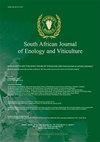用多酚/蛋白质结合模型研究乙醛诱导对葡萄酒中单体和聚合多酚的影响
IF 1.1
4区 农林科学
Q4 FOOD SCIENCE & TECHNOLOGY
引用次数: 5
摘要
多酚对葡萄酒的感官特性有很大的贡献,它们的进化受到发酵和陈酿过程中乙醛的影响。本文采用圆二色性测定和荧光光谱法,对从葡萄酒中分离出来的5种典型单体酚类标准品和3种不同的聚合黄烷醇组分在乙醛存在或不存在的情况下进行了多酚/蛋白结合的测试,并通过HPLC-MS分析观察了乙基桥连接的新低聚化合物的形成。结果表明,这些单体的蛋白结合能力依次为没食子酸>咖啡酸>槲皮素>(+)-儿茶素>(-)-表儿茶素,而乙醛对(+)-儿茶素和(-)-表儿茶素的影响更强。此外,在乙醛的参与下,不同酒组分与蛋白质反应的反应也不同,而聚合物原花青素产生的唾液蛋白质沉淀指数最大(84.67%),荧光猝灭效果最强。本文章由计算机程序翻译,如有差异,请以英文原文为准。
Influence of Acetaldehyde Induction on Monomeric and Polymeric Polyphenols in Wine using the Polyphenol/Protein-binding Model
Polyphenols make a substantial contribution to the sensory properties of wine, and their evolution is affected by the acetaldehyde present during fermentation and ageing. In this work, five typical monomeric phenolic standards and three different polymeric flavanol fractions separated from wine were tested for polyphenol/protein binding by means of circular dichroism measurement and fluorescence spectrum assay in the presence or absence of acetaldehyde, and the formation of new oligomeric compounds linked by ethyl bridges was observed through HPLC-MS analyses. The results show that the protein-binding ability of these monomers was in the order of gallic acid > caffeic acid > quercetin > (+)-catechin > (-)-epicatechin, while acetaldehyde exerted a stronger effect on (+)-catechin and (-)-epicatechin monomers. Moreover, different wine fractions had different responses when reacted with proteins with the participation of acetaldehyde, while the polymeric proanthocyanidins produced the largest value (84.67%) of the salivary protein precipitation index and the strongest fluorescence-quenching effect.
求助全文
通过发布文献求助,成功后即可免费获取论文全文。
去求助
来源期刊
CiteScore
2.50
自引率
7.70%
发文量
1
审稿时长
>36 weeks
期刊介绍:
The South African Journal of Enology and Viticulture (SAJEV) publishes full-length original Research Papers, Research Notes and Review Papers on all subjects related to enology and viticulture. The SAJEV does not accept articles published in, or submitted to, other journals.

 求助内容:
求助内容: 应助结果提醒方式:
应助结果提醒方式:


